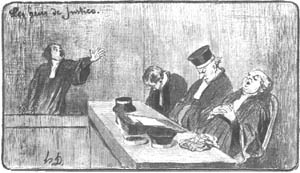Mediation Overview
summary
Mediation has become widely used these days. And with good reason. Litigation is often a fate that inflicts both expense and agony– and steals executive time and energy.
As Montaigne said, “It is often better to lose your vineyard than to go to law about it.”
But mediation is not only a process to try to resolve commercial disputes after they have occurred.
Mediation is a nonbinding dispute resolution technique in which the disputing parties voluntarily attempt to reach a mutually agreeable resolution of their dispute with the assistance of an impartial third person, who is called the “mediator.”
Even though related to negotiation, mediation may be more effective than direct negotiations between the parties. Although the mediation process has existed for centuries, American businesses did not come to commonly use it to resolve business or commercial disputes until the 1980s. Prior to that time, mediation had commonly been used to resolve disputes in the labor-management and family law fields.
Public and Private
Disputants, both public and private, have successfully used mediation to resolve a wide variety of disputes. Both businesses and the courts have discovered that mediation can resolve many disputes faster and less expensively than the more traditional alternatives of litigation and arbitration.
An example of a financial institution’s use of mediation is the settlement of a large fraud lawsuit alleging a “Ponzi scheme.” The lawsuit was brought by a group of investors against the Barnett Bank of Polk County, Florida.
Negotiable Instruments
Another example is the successful resolution of a negotiable instruments dispute involving a bank in less than two and one-half hours. The dispute involved certificates of deposit offset by the bank in a situation when the general partner in the plaintiff partnership allegedly used the proceeds of the certificates of deposits for his own purposes. The litigation involved technical evidentiary and legal points relating to ownership of the certificates of deposits and agency principles relating to the general partnership. Extensive document discovery had taken place, as well as investigation through the services of an investigator for the defendant. The complaint had been attacked by demurrer and the pleadings were at the stage where they had stabilized. A morning’s mediation produced a settlement agreement.
Types of cases
An American Arbitration Association publication lists, under the heading “What types of cases are suitable for mediation,” further examples of successful mediations of disputes involving banks. For example, a claim of fraud, negligence and mismanagement of a bank by its president was settled for $3.4 million following 21 hours of mediation. A multiparty construction dispute in which the bank had threatened foreclosure was settled for $2.8 million after 36 hours of mediation.
Among the best known of all mediated settlements involving banks was the settlement of a series of consumer class actions against Wells Fargo and other California banks. After 13 years of litigating allegations of unconscionable fees for bounced checks, the multimillion dollar dispute was submitted to mediation and was settled in a short time.
FDIC
The Federal Deposit Insurance Corporation (FDIC) has set up a pilot program that offers creditors with claims against failed financial institutions the option of using mediation to resolve the claims.
Despite the increase in popularity of mediation, many people still appear not to understand the mediation process.
Ongoing Relations
Because one of its purposes is to facilitate communication between the disputants, mediation is especially appropriate for disputes between a financial institution and its customers, employees, and other persons with whom the institution desires to maintain an ongoing relationship. One of the mediator’s roles is to provide a neutral forum for the parties to their grievances in order to give some release to the emotional content of the dispute. 
The mediator can also often determine after a round of discussions with the parties whether settlement is possible. Once the “bottom-line” settlement positions of the parties and the special concerns of each party are known, the mediator can determine whether the parties’ settlement positions are too far apart to make settlement possible.
Confidential Information
He or she will know whether the special concerns conflict in a way that precludes settlement. The mediator can then discuss with the parties the fact that settlement does not appear possible without revealing the confidential information disclosed by the opposing party. The parties can rethink their positions, or they can choose to proceed with settlement attempts. Alternatively, they can decide, with reasonable assurance, that settlement is not possible. In either case, the process can save a great amount of time and money that might otherwise have been wasted on unproductive direct negotiations.
One of the hallmarks of mediation, and one of its important advantages, is mediation’s generally private, confidential nature. Mediation’s confidentiality may be one of the main reasons for its success in creating settlements. Parties are often unwilling to disclose confidential information about their view of the case to the opposing party during direct negotiation. Perhaps they intend to use the information for the first time at trial, or perhaps disclosure would be harmful to the party who possesses the information.
“Bottom Line”
The parties also may be reluctant to disclose their true “bottom-line” settlement position, or to disclose special concerns to the opposing party. A mediator can avoid this communication roadblock to settlement. The mediator may be told these things in confidence, and he or she can use them in directing the negotiations without disclosing them to the opposing party. This might facilitate a settlement that would not have been possible in direct negotiations.
Voluntary
Another hallmark of mediation is its generally voluntary nature. Although courts mandate mediation of disputes in a few specialized areas, such as family law disputes, most mediations are completely voluntary and nonbinding, with any party free to leave at any time. Mediators help parties reach resolution of their disputes through persuasion, not through coercion. Even when a mediator does voice his or her opinions on an issue, the parties are free to disregard it.
Low Risk
The voluntary, confidential, and inexpensive characteristics of mediation makes it almost risk-free. Attempting mediation is low-risk; if mediation fails to bring about a resolution to the dispute, the parties can still submit the dispute to any other dispute resolution process, including arbitration or litigation.
Because nothing said at a mediation may generally be used in a later court proceedings the only risk to mediation is generally the inadvertent release of information to the other side that may give away future litigation positions or strategies or may alert the other side to possible avenues of discovery if the dispute does not settle in the mediations. Such a disclosure may allow the other side to gain some cheap, early discovery. However, many parties deem this risk acceptable when compared to the cost and time savings of mediation, as well as its confidentiality.
Flexible
Other hallmarks of mediation are its informality and flexibility. There are almost no formal rules of procedure, and the process itself is flexible. This informality allows the disputants and the mediator to control and design the process. Mediation’s informality often results in cost savings to the disputants. Court reporters are almost never necessary in mediations, and expert witness presentations, if used at all, are normally greatly shortened. Although some discovery is often done before a mediation, it is usually not as extensive as the discovery that must be done before trial or before arbitration. 
Mediation is generally far less adversarial than litigation or arbitration, and is therefore far less likely to damage business relations. Mediation’s informality generally allows for greater client participation in the settlement than is allowed in almost any other dispute resolution process.
Creative
Mediation’s informality may also allow for flexible and creative remedies to a dispute. For example, where the dispute involves a large institution and a consumer or small businessperson, one factor that may have led to the dispute was the consumer’s or small businessperson’s feeling that the large institution was uncaring or unsympathetic, and that it viewed him or her as just another number. In such cases, the consumer or small businessperson may be willing to settle the dispute for less money, for example, if the institution’s representative manifests a caring and sympathetic attitude or if a high ranking official of the institution writes a letter of apology to the consumer or small businessperson.
The voluntary, nonbinding nature of mediation can be a disadvantage when one or more parties are recalcitrant or cannot be trusted to honor a voluntary settlement agreement. When coercive methods are likely necessary to force a party to honor a settlement agreement or reward, an adjudicatory dispute resolution process, such as binding arbitration or litigation, may be more appropriate than mediation.
Enforceable
Disputants and their counsel sometimes seek to avoid mediation because it is not final or binding. They are worried that any mediated agreement will not be enforceable in the same ways as court judgments or arbitration awards are. However, mediated agreements may have an advantage over court judgments and arbitration awards because mediated agreements are the product-at least theoretically-of the mutual agreement and understanding of the parties. Thus, disputants can structure a mediated agreement to meet the needs of both sides. Moreover, mediated settlement agreements can, and generally should, be executed and signed at the end of the mediation session. This produces an enforceable settlement agreement.
Experience and the studies that have been conducted have shown that mediation works. Although figures vary, mediation seems to have been found to produce settlement in some settings in 75-85 percent of disputes.
Communication
Mediation works because it opens lines of communication between disputants that usually do not exist in more adversarial forms of dispute resolution, such as litigation or arbitration. Generally, once a party turns its dispute over to an attorney, that party stops all communication with its opponents regarding the dispute and leaves communication to the attorneys.
Even face-to-face negotiations usually do not include the actual disputants; they involve only the attorneys. Disputants often do not have a chance to hear their opponent’s side of the dispute until the dispute reaches the courtroom or the arbitration hearing room. By that time, the disputants are in an adversarial mode and have expended great sums of money and a great deal of time. Mediation fills this gap by opening lines of communication at an early date and providing opportunities for meaningful settlement negotiations in a safe environment earlier than trial or arbitration.
Settlement generally occurs because the disputants are faced with some deadline, such as a trial date or a judicial conference date. Mediation generally sets an earlier deadline, which may result in the disputants considering settlement earlier than they might have in litigation.
Education
Mediation also provides an opportunity to educate the other party’s decision maker as to the strengths and weaknesses of its case, as well as the opposing party’s case.
 Another reason why mediation works is that by agreeing to mediate parties are usually agreeing to attempt to work out their dispute. The act of signing the mediation agreement may reduce the adversarial feelings. If the parties do not want to work out their dispute, why agree to mediate– wouldn’t it just be a waste of time and money? By agreeing to mediate, parties signal their desire at least to discuss settlement.
Another reason why mediation works is that by agreeing to mediate parties are usually agreeing to attempt to work out their dispute. The act of signing the mediation agreement may reduce the adversarial feelings. If the parties do not want to work out their dispute, why agree to mediate– wouldn’t it just be a waste of time and money? By agreeing to mediate, parties signal their desire at least to discuss settlement.
At Any Point
Mediation is inexpensive, confidential, and fast. A typical mediation can last anywhere from a few hours to one or more days. Mediations rarely last more than a few days, even for complex or multiparty commercial or construction disputes. Moreover, mediations can be scheduled quickly and at any point in the life of the dispute. Thus, if a dispute is ripe for settlement at an early point, a mediation can usually be scheduled quickly. The disputants do not have to wait years to get their “day in court.”
Two Processes
A mediator generally employs two processes to help the parties achieve a mutually agreeable resolution. The first is case analysis. In case analysis, the mediator listens to each side give a brief analysis in private of the important issues in the dispute and the strength and weaknesses of its positions. In the safety of the confidential caucus, where there is no need to present a strong front for the other party, disputants often become more candid. They are often more willing to share sensitive information with a mediator than with their opponents. The mediator often takes the role of devil’s advocate and challenges the disputants to analyze more carefully and critically their positions.
The second process is negotiation. The mediator assists in the negotiation process by conveying offers and counteroffers between the parties. Once the mediator has a grasp of the issues and the parties’ positions, he or she can help the parties to analyze each other’s offers.
During face-to-face negotiations, disputants will often dismiss their opponents’ suggestions or offers without thorough consideration simply because the suggestion or offer came from the person they are angry with. Dispute resolution theoreticians call this phenomenon “reactive devaluation.” In other words, a disputant devalues an opponent’s idea as a reaction to the person, not to the idea. Thus, a disputant may give more thoughtful consideration to a suggestion or offer presented by a mediator than if the same suggestion or idea were presented by the opponent.
Hidden Interests
Because mediators often meet with each party in private, what each party tells the mediator is kept in strict confidence, unless the party consents to the mediator’s conveying the idea, fact, statement, or offer to its opponent. Parties often feel free, therefore, to discuss hidden interests with the mediator. Based on his or her knowledge of the facts and the issues, the mediator can help each party to develop reasonable bargaining positions. The disputants are sometimes surprised to learn that their bargaining positions are much closer than they thought when they began the mediation.
This is excerpted from ADR for Financial Institutions by Robert M. Smith (West Group, 2nd ed.1998,
1200 pp.) [Footnotes omitted]

 Advocacy in Mediation
Advocacy in Mediation